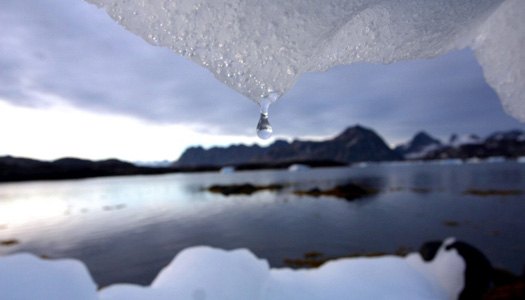
Antarctic ice is now melting at such a rapid rate, say scientists, that the continent could be at risk by 2100. And as that happens, widespread collapse of ice shelves could cause a dramatic rise in sea level. This could have disastrous consequences, including putting several U.S. cities underwater, and the window of time in which to avert this crisis is quickly shutting.
The new research, conducted by Nature Geoscience and published Oct. 12, predicts that surface melting of ice shelves will double by 2050, and lead to shelf collapse, demolishing the natural barrier against ice flowing from glaciers into the oceans. It found that if greenhouse gas emissions continue at their present rate, those ice shelves could collapse by the end of the century; and that’s not even taking into account the possibility that emissions could increase before that time.
Luke Trusel, lead scientist at Woods Hole Oceanographic Institution in Massachusetts, said the results of the study “just how rapidly melting in Antarctica can intensify in a warming climate. This has already occurred in places like the Antarctic Peninsula, where we’ve observed warming and abrupt ice shelf collapses in the last few decades. Our model predictions show that similar levels of melt may occur across coastal Antarctica near the end of this century, raising concerns about future ice shelf stability.”
The study’s co-author Karen Frey, from Clark University, Massachusetts, added, “The data presented in this study clearly shows that climate policy, and therefore the trajectory of greenhouse gas emissions over the coming century, has an enormous control over the future fate of surface melting of Antarctic ice shelves, which we must consider when assessing their long-term stability and potential indirect contributions to sea level rise.”
A separate study published in the Proceedings of the National Academy of Sciences (PNAS) showed just what would happen if this came to pass. Rising sea levels, it found, would vastly erode the U.S. coastal states, and leave several major cities underwater. By 2200, cities including Cape Coral and Hollywood in Florida, and New Orleans and Metairie in Louisiana, would be completely submerged. Other cities would be partially submerged, including Virginia Beach, Va.; Sacramento, Calif.; Miami, Fla.; and Boston, Mass. And New York City, too, would be partly underwater, displacing an estimated 1,870,000 people.
According to Scientific American, the only way to avoid these scenarios is to achieve a worldwide goal of zero carbon emissions – a highly unlikely feat. For some cities, like Miami and New York, it could mean the difference between surviving and not, while others, like New Orleans, are doomed no matter what happens.
Malcolm Bowman, an oceanography professor from Stony Brook University in Long Island, spoke in particular about New York, and how it will be affected when all that ice melts and the sea levels go up. “We could expect FDR Drive to be underwater. We could expect the water to be lapping around Wall Street. We could see vital infrastructure, hospitals, sewage treatment plants, communication conduits all paralyzed by flooding with seawater, which is very corrosive.”
Essentially, in 200 years, the Big Apple could look a lot like Venice, where storms at certain times of year swell the New York Harbor until water fills the streets. The avenues of the financial district would be canals. “You may have to build bridges or get Venice-style gondolas or your little speed-boats ferrying yourself up to the buildings,” said Klaus Jacob, a Columbia University research scientist.
And New York is just one of example out of many cities that will suffer. Climate Central has made an interactive map, which anyone can use to see how their own city or town will fare a couple hundred years from now. For states including California, Texas, Louisiana, Florida, North Carolina, New Jersey, and New York, the prognosis is not a good one.
Photo: John McConnico/AP










